Not just window dressing: High-performance curtains and blinds
Internal window coverings can protect privacy and dramatically improve the thermal function of a house, and if you choose with care, they can help keep you comfortable for years, writes Anna Cumming.
This article was first published in Issue 140 (July-Sept 2017) of Renew magazine.
Windows are a complex and interesting part of the building fabric of a house. They admit light, warmth and fresh air; they connect the occupants visually with the outside world; sometimes they frame spectacular views. But from an energy efficiency point of view they are usually the weak link in the building structure. Through windows up to 40% of a home’s heating energy can be lost and up to 87% of its heat gained, according to Your Home. High-performance, double or even triple glazing helps this equation, as does careful consideration of window size, location and orientation. But to ensure the best thermal performance of your home, you’ll need effective window furnishings. Blinds, curtains and shutters can improve a window’s performance, make your home more comfortable and reduce energy costs.

What’s the purpose?
“Internal window furnishings serve a variety of purposes, including light control, privacy, reducing glare, heat reduction and heat retention,” says interior designer Megan Norgate of Brave New Eco. Soft window furnishings can also buffer sound. If you’re building or renovating, consider window treatments as part of the design process, because taking into account the associated requirements and thermal contributions may mean you make different decisions about the extent and location of your glazing.
It’s important to consider the main purpose when choosing window coverings. If minimising heat gain in summer is the main aim, it’s best to keep the sun off the glass in the first place with an external shading device such as an eave or awning (see our article on external shading options in ReNew 138). Semi-transparent blinds or curtains are a good option if privacy or glare reduction is the primary aim; they can be combined with heavier curtains for night-time heat retention.
Thermal performance is where great window coverings really come into their own: “They can act like de-facto double glazing if they are multi-layered and tight fitting to the window,” says designer Dick Clarke of Envirotecture. Snugly fitted and insulative blinds and curtains trap a layer of still air next to the window, reducing transfer of heat from the room to the window and thus outside. They also provide a feeling of cosiness: “If you are sitting in a warm room at night between an uncovered window and your heating source it is likely you will feel a chill, partly because of the draught created by the interior heat making a beeline for the cool exterior. Properly fitted and lined curtains and window treatments are the best way to avoid this effect,” explains Megan.
Choosing your style
There are a wide range of products available depending on the purpose to be served, your budget and your design preferences.
Curtains
According to Megan, “Heavy curtains are best for thermal performance and are great to block out light, but may not work where floor space is limited or there is no space above the window to mount tracks or at the side to accommodate the open curtains.” There are other considerations to ensure your curtains are effective: they should have an enclosed pelmet at the top or drop straight from the cornice; touch the wall at either side; and just kiss the floor. If not, and as Energy Freedom Home explains, the warm air created by a heater will rise to the top of the window and be drawn down into the space between the window and curtains, driving a current of air that can rapidly cool the warm air in the room and can increase condensation.
Pelmets can usually be easily retrofitted to existing curtains and need not be visually intrusive boxes. They can be made from just about any solid material; the most common is timber, but lightweight plastic sheet or even cardboard is an inexpensive alternative, and especially useful for renters.
Elizabeth Wheeler, building designer and product specifier for Future Focused, suggests that for a streamlined look, consider integrated bulkheads instead, but notes that usually these must be factored in during the design of your home. One invisible track system that provides this integrated effect is the EZYPelmet from EZYJamb. Another invisible, easy-to-DIY option is a retrofit pelmet cap that sits between the wall and the curtain track and touches the back of the curtain; ecoMaster offers ‘Invisible Pelmets’, an acrylic product sold by the metre.
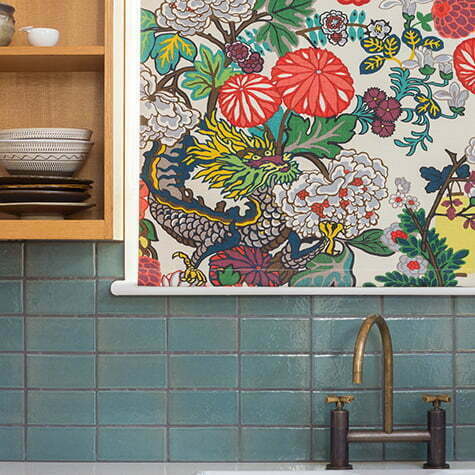
Blinds
Effective blinds come in a range of styles including roller, roman and honeycomb, and are a versatile and effective option, as long as care is taken to fit them snugly to minimise air gaps around the edges. Ideally they should be mounted within the window reveal, but if this isn’t possible, pelmets at the top can help. (Vertical blinds and standard venetian blinds can help regulate sunlight and privacy but are of limited help with thermal performance.)
Megan notes that roller blinds are generally cheapest but less thermally effective, and heavy backed roman blinds can be a good option for small and narrow windows where there isn’t room for curtains. However, her favourite type of blind is the honeycomb, a concertina style that’s made from fused layers of fabric that form a series of hexagon-shaped tubes when the blind is extended, and is very compact and visually unobtrusive otherwise. Honeycomb blinds are also known as cellular blinds.
Dick is a fan too, and summarises the benefits: “They can be blackout, or translucent to insulate while admitting some light; they can be designed to open from the top down and/or from the bottom up, providing versatility for privacy; they are very good insulators if fitted well; and they are clean and contemporary but also work with traditional decor.” Luxaflex Duette blinds by Hunter Douglas were the first to feature this honeycomb design, and they are now available in double and triple honeycomb construction for even greater insulation. Many other manufacturers offer a similar product.
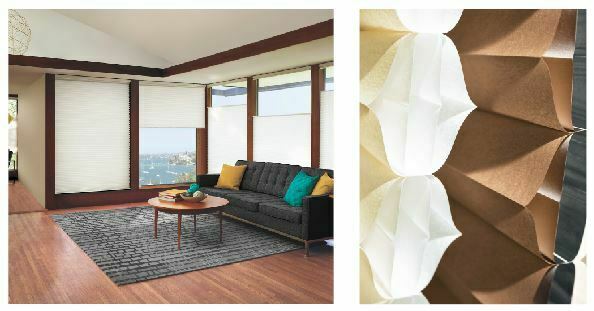
Until the WincovER scheme is up and running (see box), there is limited quantitative data available for the insulating capabilities of blinds. Luxaflex does provide R values for their honeycomb range though: up to R0.979 for their opaque, triple-honeycomb product—a significant boost to the performance of even double-glazed windows, with an R value of around 0.35.
David Baggs, CEO of Global GreenTag International, describes the ‘next tier’ of blinds as those that run in side tracks with an enclosed box at the top, much like a pelmet: “they are great as blockout blinds for bedrooms, as light doesn’t leak around the sides,” he says, “as well as performing well thermally.” Melbourne manufacturer Vertilux’s Fully Enclosed Kassett roller blinds are an example, and are available in varying degrees of light permeability up to complete blockout.

Maximising efficiency of honeycomb blinds
Energy efficiency expert Richard Keech offers the following quick and easy tip for maximising the efficiency of the popular honeycomb-style blinds: “The way these blinds are normally fitted involves a gap of about 8 mm between the architrave and the blind carrier. The gap allows air to pass which is a problem. My tip is to cut lengths of dowel and simply have them sit in the gap between the architrave and the carrier to block convective airflow and act like a pelmet.”
Shutters
Plantation shutters—usually made from timber or PVC, with adjustable blades—are currently a popular choice for interior window coverings. They provide privacy, but also block a considerable amount of light even when the blades are tilted open. While louvre or blade-style treatments are probably best suited to external shading applications, “they do have some thermal effect when used inside if you can get a good seal; it comes down to good design,” says David. “And remember that if they are timber it needs to be sustainably certified.” Elizabeth’s recommendation for choosing shutters is to “preferably source a locally made shutter that uses plantation timbers. If you can, buy the shutter unpainted so you can use your own low-VOC finish.”
Materials
When it comes to materials for your window treatments, the possibilities are just about endless. Curtains, roller and roman blinds can be made in any fabric that takes your fancy; thicker fabrics and those backed with a blockout coating will contribute more to the window treatment’s thermal performance, though data on this isn’t readily available.
Honeycomb blinds and light-admitting roller blinds tend to come in a more limited range of specially designed polyester, acrylic or vinyl fabrics, sometimes with reflective backing. Not so natural, but some brands offer options with recycled content, low-VOC (important for interior air quality) and other sustainable credentials; for example, Vertilux is proud of their Greenvision fabrics which are “PVC-free, low-VOC, Ecospecifier assessed and can also assist in achievement of points as set by the Green Building Council of Australia.”
David recommends looking for phthalate-free acrylic and vinyl products, as some phthalates can have particularly detrimental health effects when off-gassed; the Global GreenTag certification program will stop certifying products with specific common phthalates after 2019.
It’s worth looking for fabrics and products that carry an eco certification from an independent body such as Ecospecifier, Global GreenTag or Good Environmental Choice Australia (GECA). You can also look for products that can be recycled at end of life, and for manufacturers who have sustainability policies and material use and waste minimisation plans in place.
Consider durability too. Although interior furnishings are not as exposed to the elements as external window coverings, they will still need to withstand strong sunlight, especially those that are on north and west windows and designed to be used during the day rather than purely for heat retention at night. Choose good quality materials—particularly backing fabric—and ask about expected lifespan and warranties.
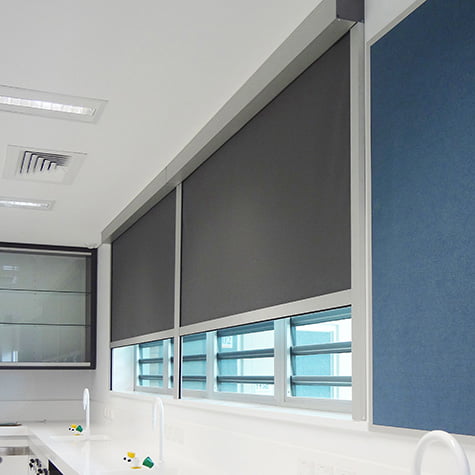
Other considerations
Ease of use: Make sure the treatment you choose is suitable for the window or door style and use; inward-opening windows will need special consideration, and a pull-down blind might just get in the way of a door opening. Take care also that blinds clear any window and door hardware like latches and winders.
Blinds and curtains will, of course, only deliver benefits if they are actually used. While it’s true that some active ‘driving’ of a house is usually necessary to achieve the best passive thermal performance, “opening and closing lots of blinds every day through summer and winter can be tedious,” says Elizabeth; this is especially true for hard-to-access blinds. “If you think you might be inclined to just give up and leave everything open, firstly consider whether you really need all that glazing. If you do, then consider mechanisation.” There are plenty of options for mechanising blinds these days, some allowing remote control via a smartphone app, and even systems that use a sun sensor to adjust blinds automatically. These systems do add considerable cost and complexity, though.
Budget: Good-quality internal window coverings for a whole house can be a considerable expense: Megan estimates $10,000 to $20,000. “If possible, it’s worth budgeting it into your costings for your home build or renovation, and thinking about it as part of the design stage.” Planning to complete the installation in stages is another option, but “you’ll need to consider how to manage your building’s thermal performance while you stage your fitout, and/or while shade plants grow,” says Elizabeth.
Maintenance: Most parents of young children would think twice about buying a white couch; window furnishings deserve the same consideration! “Think about cleaning: food and dirt from grubby mitts, dust and splashes from spills,” suggests Elizabeth. “Paying attention to cleaning and repairing fixtures is an important yet often-overlooked aspect of a more sustainable home.”
Safety: Remember to pay attention to the safety of blind cords, which present a real strangulation risk for small children. Even if you never have young visitors, the next resident might.
Strata residents: If you live in an apartment, it might be necessary for your internal window coverings to do extra duty for shading and heat reduction, as you may have limited freedom to install external shading. Exterior walls are generally considered to be common property and alterations require approval from the owners corporation; Green Strata’s Christine Byrne says that even installing film on your windows to reduce heat gain can violate strata regulations as it changes the external appearance.
Generally, you’ll have a lot more flexibility to install interior window coverings than external shading (although if you’re a tenant, you’ll probably need your landlord’s permission to drill into walls). But Christine cautions that some buildings even have bylaws about internal window furnishings, for example only permitting curtains if they have a white backing; it pays to check your strata rules before getting started.
If you are relying on internal window furnishings to prevent heat gain in summer, “consider options that still allow some light to penetrate,” recommends Elizabeth. “While they are not as effective as full blockouts, darkened rooms can be really depressing in daytime—especially for days on end.”
The next big thing?
There is certainly scope for further development in design and materials. Joe Turner is excited about the continuing development of mechanisation and automation systems for blinds, to maximise their effectiveness. On Megan Norgate’s wishlist is a blackout thermal curtain lining with recycled content and a wider range of integrated curtain pelmet and track options. Dick Clarke is looking forward to seeing the more widespread availability in Australia of integrated blinds inside double or triple glazing (also known as ‘blinds between glass’), already quite widely used in Europe.
In the meantime, when they are chosen with care and an eye for performance as well as aesthetics, interior window coverings can make a huge difference to the comfort and efficiency of your home, and the range that’s currently available is excellent.
WincovER thermal ratings
In good news for consumers, the Blind Manufacturers’ Association of Australia (BMAA) is developing a rating scheme for internal and external window coverings. The WincovER energy rating scheme, due to be launched in the second half of 2017, will provide products with a simple star rating for both heating and cooling performance, allowing easy comparisons between products. BMAA president Joe Turner explains that ultimately, a WincovER module will be added to the existing WERS (Window Energy Rating Scheme), which rates the energy impact of a window system on a house; this will give an understanding of the expected performance of window and window covering together. Keep an eye on the BMAA website for updates.
Renew readers Debbie and Dean Cipolla chose carefully integrated Roman blinds for their strawbale house in Woodend, Vic.

We owner-built our strawbale house in Woodend to an energy-efficient design, which makes use of passive solar energy and means lower energy use for heating and cooling.
We ensured that most of our windows faced north to capture winter sun and the width of eaves was carefully considered to exclude summer sun. Those that face east or west will have plantings outside to eventually provide shade in summer. All are double glazed.
We wanted our window coverings to also work well in insulating against heat and cold, while having a rustic country look to suit the house. We decided that whatever we chose must be lined with a blockout fabric, even those facing south which would not receive any direct sun. Pelmets are widely recommended for their thermal properties, but as our windows are deep set into the strawbale walls with an overhang, they were not necessary.
Eventually we chose Roman blinds as we liked the clean lines and ease of use, while still having a soft country aesthetic. When raised, these types of blinds can hang down over the top portion of the window and we didn’t want any of our views to be obstructed, so we designed a space above each window to accommodate the blinds and this has worked well. The blinds nestle snugly into the thick straw walls, resting close to the windows.
We also wanted to use as many natural and recycled materials as possible to minimise VOCs inside our new home. The fabric had to be natural and organic, while the designs should reflect the natural surroundings of our native garden. We found all of this in the beautiful fabrics of Ink & Spindle. Lara’s gorgeous designs of native flora and fauna are hand printed with water-based solvent-free inks onto organic cloth, using sustainable practices. We were able to choose the colours, mostly neutrals, to complement the décor of each room.
The blinds are performing very well; we close them early on cold winter evenings to keep the warmth in, leaving them open on summer evenings to catch any cooling breezes through open windows. During summer, we keep the east- and west-facing blinds closed while sun is shining directly on them. The front of these blinds at these times are cool, but if you put your hand behind them, you can instantly feel a blast of heat from the sun, even with the double glazing. They are certainly contributing to the passive solar design of the house and it would not perform as well without them.
Image courtesy Ink and Spindle and Amorfo Photography
If you know your way around a drill and a paintbrush, making your own pelmets is straightforward. Renew reader Ewan Regazzo describes how he built his.
I planned to install pelmets from the outset of designing my house, but struggled to find anything decent. In the end I made my own from stuff I had lying around, but slowly refined the design to what you see here (I have ten in all, ranging from 1.1 m long to a 6.2 m L-shaped gargantuan). The timber is dressed pine, purchased and cut at Bunnings when I knew what sizes I needed. Screws are light timber screws, with pre-drilled pilot holes.
The photo on the left below shows the assembly, with screw placement. The face piece (on the left in the photo) is screwed to the top piece every 30 cm or so. Avoid placing the screws too close to the edge of the timber otherwise splitting can occur. I sealed all gaps in joins and puttied over the countersunk screw holes before sanding, priming, then painting in a gloss white. I mounted the curtain rails and brackets for the pelmets first, then fitted the pelmets onto the brackets and secured them. The curtains themselves were then re-fitted to the curtain rail.
The end result is easy to make, modern-looking and highly functional!
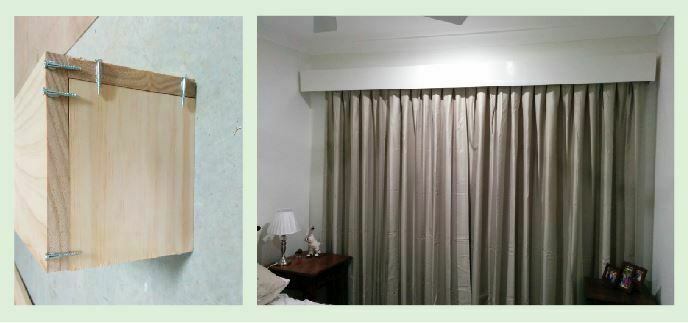
Dick Clarke, sustainable building designer and principal of Envirotecture, has been exploring the thermal insulation potential of honeycomb blinds in his home office; he describes his findings.
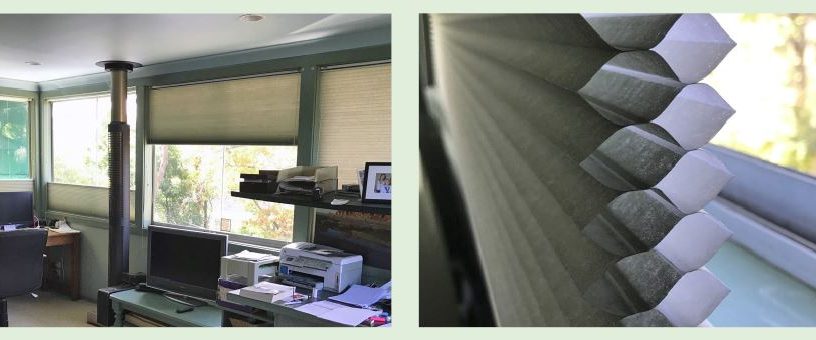
Our study/home office has a lovely view into the treetops of our backyard and across the neighbourhood to the virgin forest of the Warriewood Escarpment on Sydney’s Northern Beaches. It also faces north, which means the winter sun shines in beautifully—during the day, in fine weather.
When designing the room in 1990, I have to admit I underestimated the heat loss the glass would allow for 19 out of 24 hours even on a good day. Double glazing was not an easily available option back then, and initially I relied on venetian blinds to provide some slowdown of the heat bleed. They didn’t work very well.
Then a few years ago, after too many uncomfortably cold evenings, I discovered double honeycomb blinds, and suddenly the room went back to needing no extra heating on winter evenings. The double honeycomb provides several captive air cells, which act as insulators, almost equalling the thermal performance of double glazing. The clearance at the sides must be tight, in this case about 2 mm, which is quite effective at eliminating air exchange.
I tried, simultaneously, blinds from an Australian manufacturer and blinds made in Hong Kong from a competitive supplier, at about two-thirds of the price. Three years later, the Aussie-made blinds are still working 100%, while the blinds purchased online have failed in one way or another and are about to be replaced with the local breed. That was a wasteful and costly experience!
One of the best features of the double honeycomb blinds (after their insulation value) is the top-down/bottom-up function, which is versatile for sunlight and privacy control. I also like that they have different colours on the inner and outer faces. The supplier I chose (Beautiful Blinds) may have a slightly old-school website, but their product is simply terrific.
This article was first published in Issue 140 (July-Sept 2017) of Renew magazine. Issue 140 is our all-electric homes special, with how-tos, economic analysis and case studies.
 Efficient homes
Efficient homes
Building for a changing climate
Are we building homes for the future, or for the past? Rob McLeod investigates how climate change is impacting home energy ratings and the way we build our homes.
Read more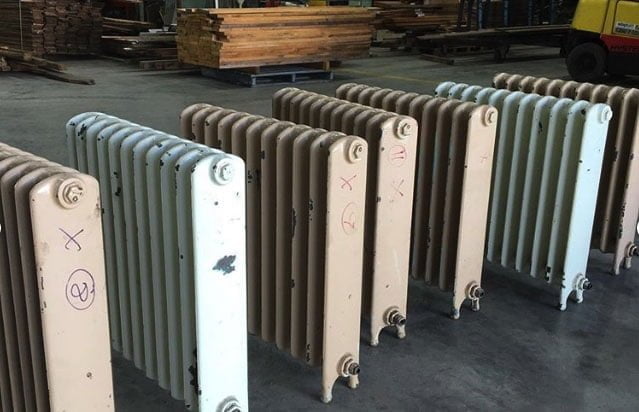 Reuse & recycling
Reuse & recycling
Recycled hydronic heat
Renew’s sustainability researcher Rachel Goldlust gives us a view of and from the Salvage Yard.
Read more Efficient homes
Efficient homes
Getting off gas FAQs
Do heat pumps work well in Australian conditions? Rachel Goldlust explains.
Read more
